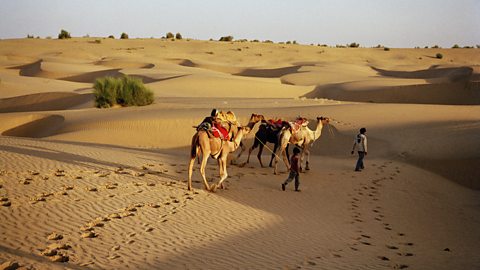Case study - the Thar Desert, Rajasthan, India
The Thar Desert is located in northwest India. It is one of the major hot deserts of the world with the highest population densityThe average number of people in a certain area. . Many people living in this desert are subsistence farmingWhen people only grow enough food to feed themselves and their family. but with increasing development opportunities, the human population is also growing. Due to population pressures this environment is increasingly under threat.

Development opportunities
Despite having an extreme climate, the Thar Desert can provide development opportunities. These include:
- Mining - the desert has valuable reserves of minerals such as feldspar, phospherite, gypsum and kaolin. These minerals are used to produce a range of things from cement to fertilisers and are therefore valuable. Limestone and marble are also quarried in the area. Limestone is used for building and producing cement, and marble is used in construction.
- Energy generation - energy is produced in the Thar Desert using solar panels. This energy is used to clean water supplies contaminated with salt (desalinationThe removal of salt from water. This is an energy-intensive process. Also known as desalinisation.). Wind energy is also used to generate electricity. A wind farm consisting of 75 wind turbines has the capacity to produce 60 MW of electricity.
- Farming - irrigationThe channelling of water from rivers and streams to fields in order to help crops grow. in the Thar Desert has made commercial arable farmingGrowing crops on a large scale for sale. viable. Producing crops such as wheat and cotton has created many jobs and generated income for the local economy.
- Tourism - the Thar Desert National Park attracts many visitors who want to see some of the 120 species found there. Tourists explore the desert with local guides on camels. Tourism is an important source of income and creates many jobs for local people. The multiplier effectThis occurs when a positive change happens, which then has a knock-on effect on other businesses. For example a new office may open, which leads to an increase in lunchtime sandwich sales at the local café and more bus passengers. of tourism creates many development opportunities.
Challenges of development
Development in the Thar Desert faces many challenges including:
- Extreme temperatures - temperatures in the Thar Desert can exceed 50°C in the summer months. It is hard for people to farm, work in mines or as tourist guides during these months as it is simply too hot. This makes development difficult.
- Water supply - the supply of water to the Thar Desert is precious and limited. With only 120-240 mm of rain falling per year in the desert, water must be used sensibly and sustainableAn activity which does not consume or destroy resources or the environment.. Without water the development of mining, farming and tourism and therefore the economy would not be possible. Some parts of the desert have experienced over-irrigation, which has caused waterlogging of the ground. Here the excess water has evaporated, leaving a layer of salt on the surface making it difficult to grow crops.
- Inaccessibility - the desert covers a huge area of 200,000 sq km. Most of the desert is inaccessible due to the extreme environmental conditions and poor infrastructure. Beyond the city of Jaisalmer, development is limited. This has created a honeypot siteA popular visitor attraction or area, where large numbers of people visit. for tourists in Jaisalmer but not beyond. The inaccessibility of many parts of the desert has led to greater differences between rich and poor.